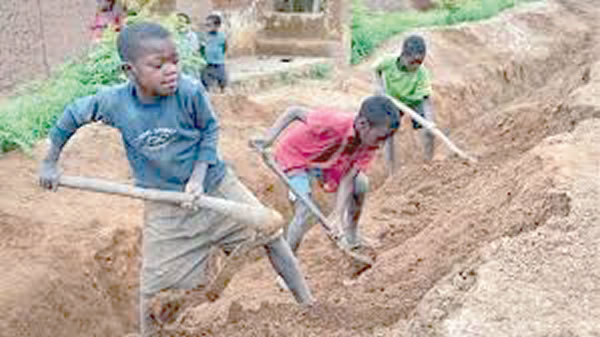Like in other countries, many children in Nigeria are engaged in child and forced labour. However, the government and stakeholders are working towards combating the menace. CHRISTIAN APPOLOS, in this report, presents some of the critical revelations made in the recently published Nigeria Child Labour and Forced Labour Survey 2022.
The menace of child labour is one of the burning issues that governments, international organisations, trade unions, non-governmental organisations and concerned groups globally are investing resources to combat.
As part of its efforts to fight the menace, the Nigerian government, in collaboration with the International Labour Organisation (ILO), with the support of the Netherlands Government and the United States Department of Labour (USDOL), recently produced Nigeria Child Labour and Forced Labour Survey 2022. The document made important revelations as it contains the much needed information to battle the menace.

One of the significant revelations of the document is that household structures and factors contribute tremendously to the proliferation of child and forced labour menace. For instance, it said that “Child labour in many contexts is strongly negatively correlated with the education level of the household head. A possible explanation is that better educated parents have greater knowledge of the benefits of education and/or are in a better position to help their children exploit the earning potential acquired through education.”
It also noted that “Children from households with more children are typically more likely to be in child labour, presumably because larger households have more dependent members to support. The presence of more prime-age adults in the household has the opposite effect, reducing the likelihood of children’s employment. The effect of elderly household members can vary – old age pensions can help to ease household resource constraints and dependency on child labour, but the opposite can occur in cases in which old age pensions are not available.
Just as it noted that “Child labour is typically much more common among children from low-income and/or poor households. This result points to the fact that socio-economically vulnerable households are more likely to have to resort to child labour to meet their basic needs. The poverty-child labour link is also mutually reinforcing. Children whose education is denied or impeded by child labour enter adulthood lacking the skills needed for decent work, leaving them more at risk of poverty as a result.

“The employment status of the household head can be another important indicator of socio-economic vulnerability. Heads of households who are unemployed or who are outside the labour market altogether are more likely to be in situations of socioeconomic vulnerability and, concomitantly, to have to resort to their children’s labour as a result.”

The document also stressed that “the contractual status of employed household heads likewise is linked to household socioeconomic vulnerability. Households can be forced to turn to child labour to pay their debts. In extreme circumstances, household debt can be associated with debt bondage involving children.”
It went further to stated another factor is “a shorter distance to school reduces the direct and indirect cost of travel to attend school, making schooling more attractive as an alternative to child labour. Parents may be especially reluctant to allow their daughters to travel long distances to school for cultural reasons as well as cost considerations, and thus school proximity can be a particularly important determinant of girls’ primary and schooling and work.”
It added that “Research also suggests that the presence of a secondary school in a community can play a role in parents’ decisions about children’s schooling and work earlier in the education cycle. Parents may be less willing to invest in their children’s primary schooling when there is no opportunity for their children to proceed to secondary schooling, where the returns on their investment in their children’s education in the form of better job prospects begin to be realised.
“Access to better services can be an important determinant of child labour in large part because it influences the value of children’s time outside the classroom. In contexts where access to basic services, such as water, electricity and gas networks is limited, children may have to shoulder a greater burden of tasks such as carrying water and fetching fuelwood.”
Notably also, the survey talked about the forms of work, employment and branches of economic activities that encourages child labour. “Disaggregating the economic activity in which children in child labour are involved by form of work can help better understand child labour. In line with the latest international measurement standards, forms of work include own-use production of goods, employment work and unpaid trainee work. Each child in child labour is involved in at least one of these three forms of work if not more than one. It should be noted that collecting firewood and fetching water are both activities included as own-use production.
“In Nigeria, of children five to 17 years old in child labour, 93.8 percent are working in own-use production, 24.2 percent are in employment and 11.3 percent are in unpaid trainee work. Own-use production work is the most prevalent form of work across the age groups and other background variables. Younger children in child labour (in the five to 14 age group) are more likely than their older counterparts to be involved in own-use production of goods (95.3 percent versus 87.0 percent). However, children in child labour in the 15-17 age group are more likely to be found in employment (43.5 percent) or unpaid trainee work (20.0 percent) than children in the five to 14 age group (19.9 percent in employment and 9.3 percent in unpaid trainee work).
“Looking at both sexes, female children in child labour are more likely than males to be engaged in own-use production work (94.7 percent versus 92.9 percent), whereas male children in child labour are more likely to be found in employment (27.1 percent of boys compared to 21.2 percent of girls) and in unpaid trainee work (12.0 percent of boys compared to 10.5 percent of girls).
“As mentioned, own-use production work is most common regardless of the area of residence, but it is more common in rural areas where 95.7 percent of children in child labour are involved in this form of work versus 89.0 percent in urban areas. Children involved in child labour in rural areas are also more likely to be in employment work than children in child labour in urban areas (25.9 percent versus 20.1 percent). In urban areas, children in child labour are more likely to be involved in unpaid trainee work than their rural counterparts (17.8 percent versus 8.6 percent, respectively).”
On child labour in employment, it says, “Of children involved in the form of work of employment (24.2 percent of children in child labour), it is possible to further break down employment into categories based on the branch of economic activity (agriculture, industry and services) or the status in employment (contributing family worker, employee, own-account worker or other).
“Employed children in child labour can be classified by branch of economic activity. Following the International Standard Industrial Classification (ISIC, Rev 4), which is used to classify economic activity in most national statistical systems, the results show that the most common branch of economic activity for employed children five to 17 years old involved in child labour is the agriculture sector (56.8 percent of children), followed by the service sector (25.8 percent) and industry (17.4 percent).
“Children’s involvement in agriculture is particularly high for employed young children in the five to 14 age group in child labour, at 61.4 percent compared to 48.4 percent of children in the 15-17 age group. Involvement in the service and industry sectors increases with age: 27.7 percent of employed children in the 15-17 age group in child labour work in the service sector and 23.9 in industry.
“While most male and female employed children in child labour are concentrated in agriculture, girls (34.1 percent) are more likely than boys (19.8 percent) to be found in the service sector. More boys work in the agriculture sector than girls (62.0 percent versus 49.6 percent). Engagement in industry is similar by gender (16.3 percent of girls and 18.2 percent of boys).”
Another significant point it raised is on the status of employed children. “Employed children in child labour can also be classified by status in employment. The distinct categories are contributing family worker, own-account worker, employee or other, where other comprises apprentices/interns and children helping family members in their job. Contributing family work is work to assist any member of the household in any business or farming activity that generates income. Children in own-account work are self-employed, that is they have personal business or farming activities that generate income, while employees are children in child labour who work for pay for someone who is not a member of the household.
“Considering the status in employment of children in child labour five to 17 years old, almost half are contributing family workers (41.5 percent) and more than a fourth are in child labour as employees (25.8 percent). Children in own-account work represent the lowest share of those in child labour and employment at 14.3 percent.
“While children involved in contributing family work represent the majority of children in child labour and employment at any age, young employed children in child labour (in the five to 14 age group) are more likely to be contributing family workers (46.5 percent) than their older peers in the 15-17 age group (32.5 percent). Employed 15 to 17-year-olds are more likely to be in child labour as employees (30.8 percent) and own-account workers (17.3 percent) than the younger five to 14-year-olds (23.0 percent and 12.6 percent, respectively).
“In addition, female children five to 17 years old work more as a contributing family worker (46.5 percent) than their male counterpart (37.8 percent). Employed male children in child labour are more likely to be an employee than their female peers (27.2 percent versus 24.0 percent). The percentage difference between male and female children involved in own-account work is small (15.1 percent for girls and 13.7 percent for boys). A greater proportion of female children in the five to 14 age group (52.1 percent) work as a contributing family worker than male children (42.3 percent) Male work status as an employee is also notable at 25.1 percent in the five to 14 age group compared to 20.2 percent for females. Focusing on area of residence, children in child labour and employment work more as a contributing family worker in rural areas (44.7 percent) than in urban areas (33.0 percent).”
ALSO READ: HIV infections, teenage pregnancies rising in Nigeria, NGO warns








